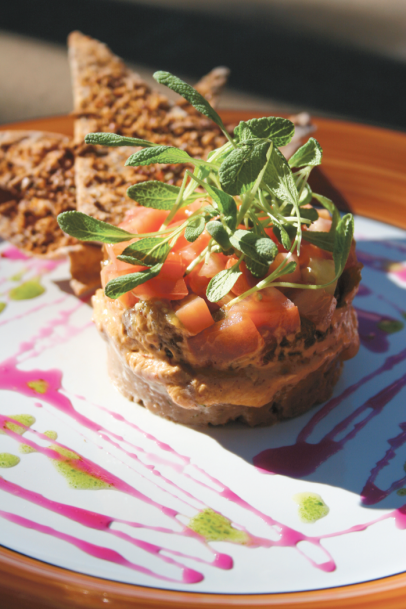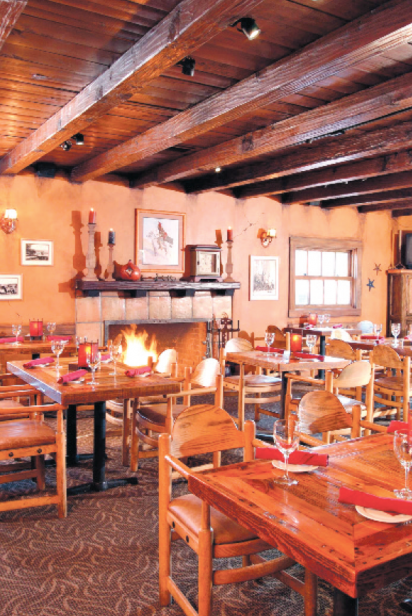Local Chef Looks to the Past to Find a Sense of Place
It’s not surprising that the son of a horse trainer and a Western banker ended up with a posse of his own named Tonto, Cartwright, Stables and Dos Silos. What is surprising is that the posse isn’t a herd of horses or a string of financial institutions. The self-proclaimed “black sheep of the family” bucked the notion that he’d fill his father’s banking boots, and instead followed his heart into restaurant kitchens.
Eric Flatt, 43, co-owner of a pack of thriving Arizona eateries, moseyed into a Colorado restaurant on the western slope of the Rockies as a teenager to wash dishes after school. By the age of 19, he was the head chef at one of the few fine dining restaurants in the town of Grand Junction. After a brief respite to try college life as an appeasement to his parents, he sauntered back into the restaurant world without as much as a tip-of-the-hat glance back.
Flatt doesn’t think of himself as a history buff—he’s too modest and doesn’t take well to labels—yet all of his restaurant ventures incorporate historical elements into the names, the décor and the menus.
“I just love the culture that’s here, you know, and we really try to encompass that. All of our restaurants are immersed in so much history, it’s only natural that I’m drawn to the past,” Flatt says.
He doesn’t consider himself much of a cowboy, either, although his flannel shirt, worn jeans and weathered boots might suggest otherwise. The burly, handsome fellow could be a cowboy—or a pro halfback, given his size.
“I’m a country boy, not a cowboy,” Flatt says gently, still bucking his ranch upbringing.
He’s bucking another trend these days by retaining his successful restaurateur status in these tumultuous times. Even in a good economy, restaurant failure is high: 60 percent within the first five years, according to a story published in Business Week last year. His first restaurant, Tonto Bar & Grill at Rancho Mañana Golf Club in Cave Creek, is celebrating its 15th anniversary. Cartwright’s Sonoran Ranch House, a mere mile due east of Tonto, opened in 2000. And, in 2008, Flatt and his partners opened the Stables and Dos Silos in Tubac, Arizona, at the recently renovated and expanded Tubac Golf Resort.
Flatt’s success as a restaurateur seems to be the culmination of practice and passion. His work ethic developed early on, growing up on a ranch where school hours were sandwiched between early morning and late evening chores. Flatt attended culinary school in San Francisco and worked in local restaurants for next to nothing while he was in school. He labored seven years as one of the key chefs at the Lodge at Pebble Beach in California. There, among other duties, Flatt was in charge of feeding 60,000 people a day during the resort’s national golf tournaments, cementing his commitment to long hours—and proving he had stamina. And his drive? That’s just inherent from his love of the hospitality industry and his personal desire to succeed.
Flatt is quick to equally credit others with the long-running success of his ventures, including his longtime business partner John Malcolm, who met Flatt when Malcolm completed his culinary externship at the Lodge at Pebble Beach under Flatt’s tutelage. Fate or not, both Flatt and Malcolm found themselves in the Valley at the same time several years later and met up to play a round of golf at the newly opened Rancho Mañana Golf Resort. The historic property was once a working cattle ranch known as the old Howard ranch. When it sold in the mid- 1940s and was renamed Rancho Mañana, it became one of Arizona’s most successful guest ranches from 1946 to 1955. The property was sold again and converted into an 18-hole golf course during the early 1990s.
Flatt told Malcolm he was considering opening a restaurant on the property. Malcolm said “I’m in” and the partnership began.
The dynamic duo swung open the doors to Tonto Bar & Grill in December 1994, promptly establishing the restaurant as one of the Valley’s premier Southwestern restaurants. Flatt headed the kitchen while Malcolm handled the front of the house, although with their expanded territory these days, the partners no longer cook or play host on a regular basis, and have instead, evolved into multi-unit business managers. Even so, it’s not unusual to see Malcolm greeting guests, or Flatt emerging from the kitchen.
Tonto’s décor is casually upscale Southwestern, with hacienda accents and scenic views of Elephant Butte and Continental Mountain from the enclosed patio. The restaurant is at once rustic and romantic. The menu—an evolution itself, Flatt says—is stamped heavily with Southwestern ingredients, but not exclusively so. He says part of the restaurant’s longrunning success is staying true to “who we are.”
Flatt recalls a conversation he had with the chef he brought in to take over the day-to-day cooking several years ago. “I said, ‘You know how people are doing frothy sauces, foams, frozen foie gras bubbles and all this crazy stuff?’ and the chef says ‘Yeah! Yeah!’ and I say ‘We’re not going to do any of that. In fact, we’re going back to the native foods.’” Turns out, looking to the past is just as exciting (and fashionable) as cutting-edge cooking.
Tonto, a Southwestern restaurant from the get-go, became even more focused on the region. Today’s menu is peppered more liberally than the original with chiles, squashes, beans, corn and ancient grains.
“I feel that the natural flavors indigenous to the area should be incorporated into the dishes. It just makes sense that those ingredients work well together,” says Flatt.
His interpretation of the connection between the land and the restaurant unfolds through his menus. The Indian harvest torta appetizer, for example, is the embodiment of what Flatt set out to achieve with the “taste of native Arizona” Tonto tagline. The torta starts with a short tower of Anasazi beans braised with onions, tomatoes and chiles and is finished with Ancho chile goat cheese, palm dates harvested from the grounds and sun-dried tomatillo relish. Jagged pieces of crisp, ancient three-grain flatbread—kamut, amaranth and quinoa—encircle the tower, virtual utensils to scoop up the metaphorical tribute to the desert.
The menu features several Native Seeds/SEARCH products from the nonprofit seed bank based in Tucson, including tepary beans. It features local Desert Sweet shrimp farmed in Gila Bend and Strawberry’s Fossil Creek Creamery goat cheese. Some of the ingredients, like the palm dates and prickly pear and saguaro fruits, are harvested from the property and surrounding desert that nuzzles up to Rancho Mañana.
“Harvesting is not easy, but there is something self healing and satisfying when you harvest from nature, whether it’s plants or animals,” he says. “My hope is that we’ll be able to harvest even more from nature and incorporate these items into our menu.”
And then there’s that dang pork schnitzel with warm German potato salad, and spice grilled apples. Huh?
“Yeah,” Flatt laughs, “there are some holdovers we just can’t take off the menu, or there’ll be an uprising.”
Flatt’s savvy enough to know that pleasing customers is what really makes their restaurants successful. Partner that business acumen with a keen sense of place and an owner who doesn’t mind bucking trends and the result is a stable of, well, stable restaurants—even in these untamed times.
Gwen Ashley Walters, a restaurant critic and food writer, has a soft spot for old dude ranches, having spent years visiting and writing about them for her first book, The Great Ranch Cookbook.
THE RESTAURANTS
Tonto Bar & Grill
The menu touts the use of “as many native Arizona products as possible” and the desert-draped dishes are only occasionally interrupted by Asian-infused offerings or homey liver and onions and the pork schnitzel referenced in the article. Nestled up against the lush Rancho Mañana golf course, the interior is equally posh and thoroughly Southwestern, belying the “bar & grill” moniker. 5636 E. Rancho Mañana Blvd., Cave Creek; 480-488-0698; tontobarandgrill.com.
Cartwright’s
Where Tonto Bar & Grill embodies the spirit of the Southwest, sister restaurant Cartwright’s Sonoran Ranch House is pure chic cowboy, serving mesquite-grilled steaks and seafood. Besides Arizona-raised beef, the menu features elk, buffalo and house-made sausage. The Cartwright name hails from the once palatial ranch (65,000 acres) near Seven Springs, established in 1887 and owned by three generations of Cartwrights. 6710 E. Cave Creek Rd., Cave Creek; 480-488-8031; cartwrightssonoranranchhouse.com.
The Stables
In a nod to the Spanish heritage of Tubac, the Stables Ranch Grille delivers a mix of Spanish, Mexican and Native American dishes served in an Old World atmosphere. The restaurant is built on the site of the historic Otero ranch stable, but it’s unlikely the vaqueros tending to the horses ever had anything like a skillet of garlic-sautéed local Desert Sweet shrimp with Serrano ham, sherry and Spanish olive oil.
Dos Silos
Named after two (retired) grain silos on the original Otero ranch property, the colorful, Mexican-inspired Dos Silos sits at the center of the newly renovated Tubac Golf Resort. Menu staples like the chile relleno de puerco (pork-stuffed Poblano pepper with roasted tomatillo sauce) are served with sides of smoky frijoles and corn casserole.
Stables Ranch Grille and Dos Silos Mexican Cantina:
1 Otero Rd., Tubac; 520-398-3787; tubacgolfresort.com.







